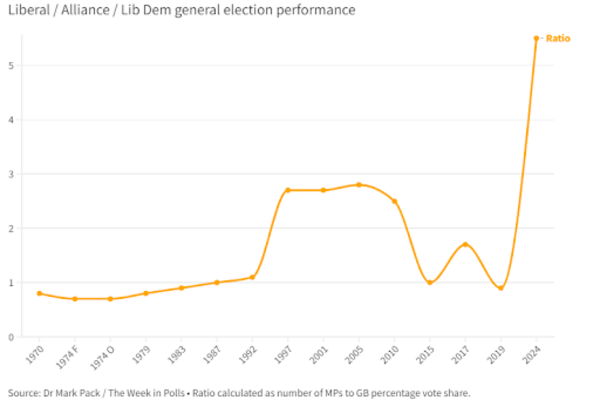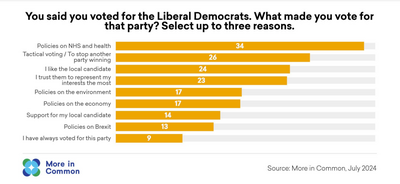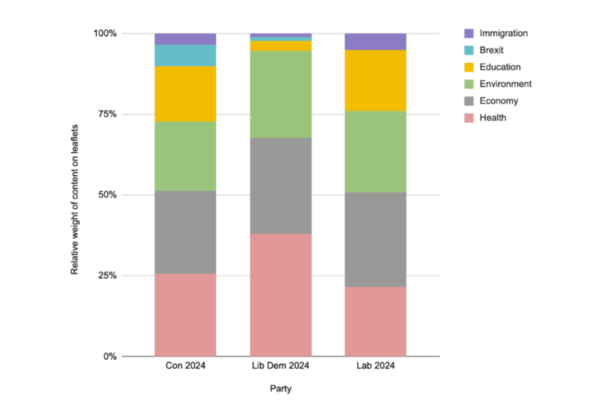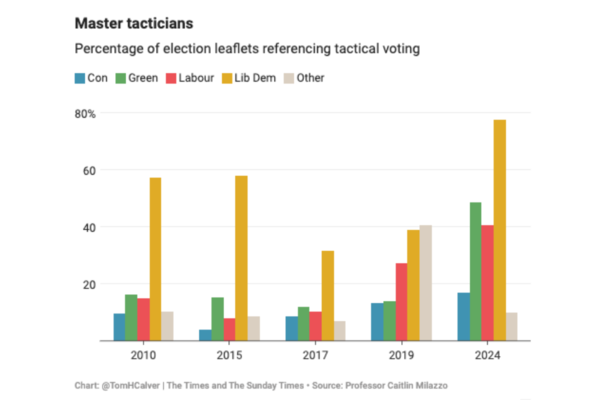How did the General Election result happen?
Party President Mark Pack writes about the general election, initial thoughts on lessons and what the Federal Board is up to next.
Thank you
From our low of 6 seats in 1959 through to our then peak of 63 in 2006, gaining 57 seats took 47 years. We've now gained 61 seats in just 5 years. It was an amazing team achievement, and we all should be proud of the roles we have played.
Perhaps the most amazing helper is our kind deliverer Geoff, who both campaigned locally and in a target seat, a mere 79 years(!) after he delivered his first leaflet as a very young deliverer in the 1945 general election.
Whether it was your first or your twenty-second general election, and whether you helped with leaflets, canvassing, money or in one of many other ways, thank you.
This is what you did:

A particular thanks too to those who worked so hard on campaigns that did not quite make it this time. Just missing out is always frustrating, and all the more so when so many others around you are celebrating. I hope though our other successes can give you hope that success will come in your area too in the years to come.

What happened
That photograph did not happen by accident. Although Rishi Sunak, and before him Liz Truss and Boris Johnson, gave us a helping hand, it was a result we created - deliberately, following a plan all through the Parliament.
We did so by breaking all previous records for the effectiveness of targeting:
Nor was this just due to split opposition votes, because the Lib Dem vote share in the seats we won was impressively high, as Patrick Dunleavy’s figures show:
| Party | % of each party's MPs | Number of party MPs | ||||||
| Labour | Cons | Lib Dem | SNP | Labour | Cons | Lib Dem | SNP | |
| Majority support (>50%) | 17.0 | 0.8 | 26.4 | 70 | 1 | 19 | 0 | |
| Large plurality (over 40%) | 52.9 | 18.7 | 50.0 | 218 | 23 | 35 | 2 | |
| Small plurality (<39.99%) | 30.1 | 80.5 | 23.6 | 124 | 98 | 17 | 7 | |
| Total seats | 100% | 100% | 100.1% | 412 | 121 | 72 | 9 | |
1983 was the high point of the Alliance and previous attempts to break the two-party system in Westminster. Compared to then, we secured half the votes this time - but three times as many seats. In a political system where the currency of success is seats, that is quite the success.
Of course, the national campaign had an important part in that too. It was a national campaign focused on the voters and media outlets that most mattered for winning seats, and which caught the public’s imagination:

That image captures one of the important lessons from our 2019 election review: the importance of strong visual images to cut through a crowded media landscape and to reach a public often not that interested in the details of politics.
Though I suspect none of that review team - whose work was essential to guiding our work through the last Parliament - quite foresaw what visual images would be coming…

The response from voters came through clearly in the polls:
How it happened
There will be more lessons to digest as there is more time to hear feedback and analyse the evidence, both of what worked well and of what areas we need to work on for next time.
The broad picture though has some clear features. Success came from:
- Concentrating on the issues that mattered most to voters;
- Building strong teams in our most promising areas;
- Explicitly targeting seat numbers rather than vote share - aiming to win seats where we could and to build up our organisational strength elsewhere;
- Investing early in intensive support for our candidates and campaigners in our most promising areas;
- Taking each round of elections seriously, with each important in its own right but also as a building block for the next too; and
- Working together as one team, following a collective strategy based on what you, party members, decided at our conference.
That comes through in the reasons people gave pollster More in Common for voting Liberal Democrat:

In other words, health and social care, bar charts and great candidates.
That was reflected in, and caused by, our relentless message discipline, as shown by independent analysis of what appeared in election leaflets by Tom Calver for The Times.
Our literature most focused on health and social care, and our repetition of tactical voting messages was intense:


-
Percentage of election leaflets referencing tactical voting
Party 2010 2015 2017 2019 2024 Con 9 4 9 13 17 Green 16 15 12 14 49 Labour 14 8 10 27 41 Lib Dem 58 58 32 39 78 Other 10 9 7 41 10
That leads to five provisional thoughts on what we can learn from this election for the ones to come.
Concentrating on what matters to voters
We talked about sewage leaking into hospitals, while the Conservatives talked about the lanyards worn by doctors. What issues those are may change during this Parliament, but the principle will remain a good one.
And we can also finally lay to rest the ghost of tuition fees by showing people that the issues we campaigned on are the issues we deliver on during this Parliament. Events will no doubt throw up unexpected new issues - they always do - but our top priority must be showing that what people voted for is now what people will get.
Tactical voting is more than just bar charts
Tactical voting comes not just from delivering bar charts. Success at local elections in the preceding years and creating a strong local organisation to deliver regular communications, to knock on many doors and to set up a bountiful poster display, are what makes the tactical voting message credible.
There will be lessons there to digest about how we spread the number of seats with such a level of organisation in this Parliament, in particular to some seats where we finished neither first nor second.
The race for local credibility
That leads to a wider point: most areas are locally a two party system but who the two parties are varies around the country. There is a multitude of different two party systems around the country. Our success comes from making ourselves one of those two parties. In many places we have done so. Often in rivalry against the Conservatives, but also in areas up against the nationalists or Labour too.
In many others, who at least one of those two parties will now be is up for grabs, especially in areas of - current, at least - Labour dominance. There is a race to be had in many parts of the country to establish ourselves as the credible challenger to Labour, to make the local two party system a Labour-Lib Dem one.
Great candidates are made
Great local candidates do not just appear. They are headhunted, supported, developed, trained, encouraged and selected. For our most promising seats in the Parliament just gone, we did more of that and sooner than before. It will be an important issue to consider for next time about how we repeat that, and on a broader front.
That is also a key part of continuing to improve our record on diversity and inclusion. You can see the benefits in our top target seats of the concentrated effort they got to improve our candidate diversity.
As you go down the list, you can see that impact tailing off - a clear sign that there is more to do.
Scaling up support
Much of what we did was on a larger, more coordinated scale than before, such as the central purchasing system for our target seat campaigns. Many of the innovations this time also helped reduce the administrative burden for local campaigners, such as the common shared budget spreadsheets for target seat campaigns and the template designs for literature.
Some of that was rolled out more widely - with additional seats during the campaign able to buy into our (remarkably cost-effective) digital advertising, for example.
How we scale up that sort of support to a larger slice of the country will be an important organisational challenge, particularly given how well we did at turning second places in 2019 into wins in 2024. That is definitely the best fate for second places! But it presents us with a new challenge too in a world in which we won 72 seats and came second in 27.
Those are though, only provisional lessons. First thoughts based on early data and early feedback. We all need to work together to fully think through what worked, why and how we can build on that.
Star local parties
During the campaign, I highlighted each week local parties that were doing best at recruiting new members and at contacting their members and registered supporters. In other words, that were making the most of the general election to help build up their local organisation, especially outside our target seats.
So to wrap up, huge kudos to the three local parties outside our target seats in each of England, Scotland and Wales who did best at recruiting new members:
- Liverpool
- South Edinburgh
- Cardiff & the Vale of Glamorgan
And here are the three who contacted (and recorded in Connect!) the highest proportion of their members and registered supporters:
- Aylesbury
- Rutherglen and Hamilton West
- Clwyd North
Well done to those teams and everyone else who got stuck into this task.
What next?
For the Federal Board meeting in July we will be taking an initial look at the lessons and immediate budget and organisational decisions arising from the general election. That includes setting up a general election review and catching up on various administrative matters that were on hold due to the election, such as filling a vacancy on the Federal Appeals Panel following Thomas Hood standing down.
We will report further on all this to our Federal Conference, now back to a normal, full length event. You can register for conference online (and when doing so, please make sure to set the country in your address to ‘Great Britain’ rather than ‘United Kingdom’).
I look forward to seeing many of you there.
Do you have questions on any of this report, or other Lib Dem matters? Then please drop me a line on president@libdems.org.uk. Do also get in touch if you would like to invite me to do a Zoom call with your local party or party body.